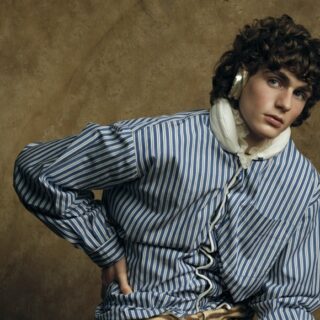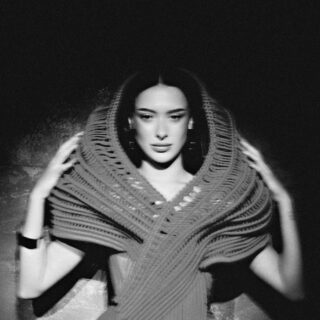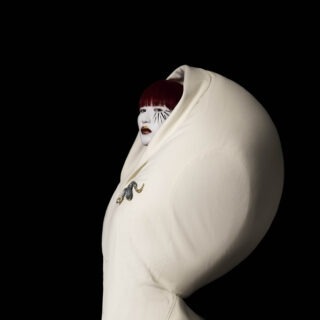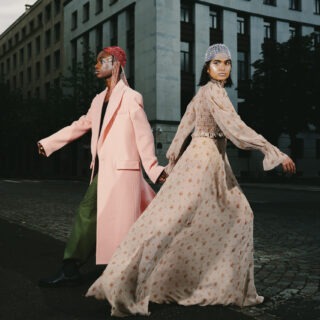words. Odyssia Houstis
photography. Winds of Yawanawa
issue 4 – in motion
What type of child were you growing up?
As a child, I was quite the nerd. I got my first computer at eight, and in a time without the internet, it was more than a tool; it was a friend. This was a significant influence on my upbringing. The games I played fostered my imagination, and I had a keen interest in mathematics, especially geometry. This unique blend of technological engagement and academic interest seems to be a common thread among programmers of my generation. Our fascination wasn’t derived from school but rather our own curiosity and our imaginative world.
Was art also a part of your upbringing, or did your interest in this area emerge later on?
Creativity was always at the heart of my interests. As a child, I enjoyed creating my own levels and worlds in games, my own narratives. This playful, virtual construction was both basic and exhilarating. By high school, I was already into photography, web design, and programming. Then in college, my interests expanded to typography, non-linear video editing, and a different, more abstract approach to storytelling. All this journey was shaped by growing up in Istanbul.
Could you describe the moment when you realized you wanted to merge art and technology? Intrigued by technology’s potential, I conceived “data painting” during my 2008 undergrad years, envisioning architecture as more than static shields against nature. Despite advancements from architects like Frank Gehry, I found the field stagnant, foreseeing AI’s inevitable integration into architecture. I aspired for interactive buildings, capable of remembering, dreaming, hallucinating. These groundbreaking ideas earned a Microsoft Research award in 2013. Initially faced with skepticism, I thrive on challenges and venturing beyond comfort zones, convinced that the union of art and technology exists in these uncharted territories.
Can you pinpoint the moment when you realized you wanted to create large-scale public installations?
It was in 2011, a very clear memory. I was just a design student, yet I was given the chance to mount my first serious installation in Istanbul during the Biennale. It was an ambitious project, transforming a giant city building into a massive media wall. Despite encountering skepticism – my proposal to include a frame was deemed too peculiar, and too costly – I persevered. It was in that moment, bringing together public art and data, that I understood the scale of what I could achieve, how far I could push the boundaries. This was my limit in Istanbul, and it felt right.
Could you discuss any hesitation or rejection you faced during your journey?
Quite contrary to your assumption, the reception was overwhelmingly positive. It was an incredible moment, seeing my sculpture stand in the center of the city. I received an abundance of appreciative reactions online. As for the origin of innovation, I identify it as Silicon Valley. Hence, my decision to settle in LA, a city close to entertainment, arts, and technology. When I undertook a project in Istanbul, it raised questions – what could I achieve with a team? With resources? Currently, I maintain a small team, but I also harbor dreams of expanding to a studio with a more organized plan.
You’ve collaborated with giants such as Google and Nvidia, and your work graces the city of San Francisco. How did you manage to convince these powerhouses to adopt your vision? It was in the context of a competition in which over a thousand artists participated. My approach was different; I didn’t propose a traditional painting or a bronze sculpture. Instead, I suggested the art be integrated into the architecture, alive and fueled by the city’s data. The reception was initially disbelief, even doubt about its longevity given its public nature. But now, nine years on, it’s still functioning, not just in the Salesforce tower but also in Chicago. That achievement was a turning point, gaining recognition from ordinary folks to tech giants.
Your work often seems to draw from a rich tapestry of influences. While I understand you enjoy nature and classical music, is it fair to say that these are your main sources of inspiration? Interestingly, it’s not so much nature or music that influenced my creativity, but science fiction and, indeed, science itself. I am deeply inspired by the breakthroughs happening in our world right now. Although I respect the work of traditional artists, I don’t find them personally inspiring. Instead, I am enthralled by the people in laboratories, those pushing boundaries and making scientific discoveries. Their journeys, their relentless pursuit of knowledge, spark in me a flame of inspiration.
Do you envision AI-generated art evolving into a distinct genre?
Possibly, but in my opinion, art created by AI lacks the elements of chance and control, making it overly engineered and less likely to lead to breakthroughs. I find the real opportunity for change comes when creating our own models from scratch, but this requires considerable research, computation, and know-how. It’s a luxury to use your own data to generate unique AI models, but it’s in that space that significant innovation occurs when you have the power of AI and your own ideas.
In your projects like Machine Hallucinations where you used public data, how do you navigate data protection issues?
I work only with online, copyright-free collective memories, never using private data. This approach allows me to create from scratch, maintaining ethical boundaries in my work.
There’s considerable fear and hesitation around AI. Given that you use AI to explore our memories, do you see it as an extension of human consciousness and integral to creating multiverses using our memories?
Indeed, I view AI and consciousness as interconnected, although not yet perfectly designed. We’ve encountered various needs and problems throughout human history, and AI represents a unique solution with cognitive capacity. It is the first invention with such intellectual potency, going beyond the simple intellectual context that the printing press and similar inventions have provided. This emergence of collective consciousness and intelligence could lead to a new renaissance converging the internet, blockchain, and AI, causing a significant shift in our understanding of life.
What is your vision for how this development might unfold?
I envision a future where artificial realities created by machines and software become our reality. We’ve never had the opportunity to create reality like this before. Previously, our constructs were confined to ideas and intellectual entities, but now we can make them tangible – you can see, hear, smell, and taste them. I predict that we’ll reach a point where the senses of taste, touch, and smell are fully incorporated into these artificial realities, significantly altering our concept of reality.
Your ‘Glacier Dreams’ installation included a smell component. How did this come about? And how do you recreate the scent of a glacier? Over the past four years, inspired deeply by nature, especially amid the pandemic, I’ve focused on its understanding, respect, and conservation. I’ve delved into concepts such as ‘Flower Three Clouds’ and ‘Glacier Dreams,’ enhanced by expeditions that instilled an appreciation for our physical world. My work attempts to encapsulate awe, nostalgia, and concern for our changing planet. Eric Sorachi introduced me to a project with half a million scent molecules three years ago. We integrated this scent data into my ‘Glacier Dreams’ installation, pushing multisensory art limits. The scent—an intensified smell of glaciers—left a strong sensory memory, encouraging environmental empathy. This artwork underscores our role in nature, underlining its powerful superiority despite technological progress.
How can we foster a balanced digital and real-world education for young children, while equipping them with essential skills for their generation?
I have suggestions based on my nine years of teaching 20-something-year-olds, the young individuals who excel are those who are unbound—free from biases related to titles or tools, free from the weight of societal norms. Our classroom, a melting pot of 30 students from 14 countries, allows me to witness the brilliance that can spring from a variety of cultures. Regardless of their backgrounds, the most innovative ideas come from the fearless children, those who’ve been given the freedom to experience and explore life without limitations.
words. Odyssia Houstis
photography. Winds of Yawanawa
© Schön! Switzerland. All rights reserved.






